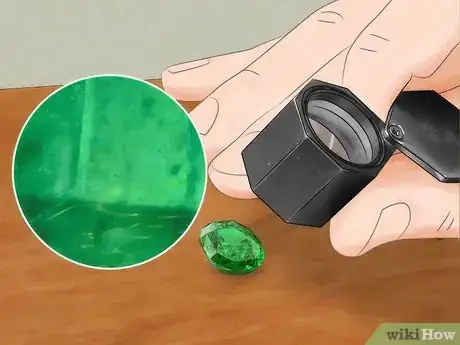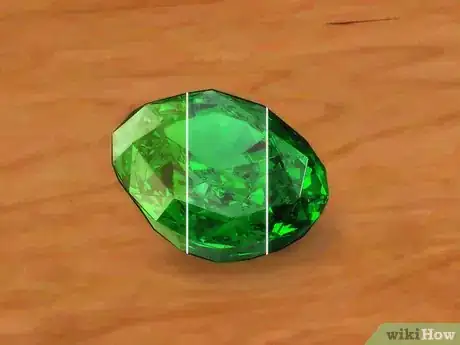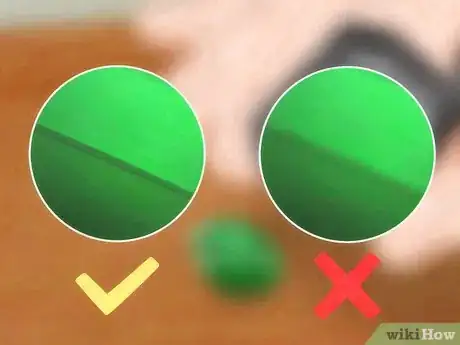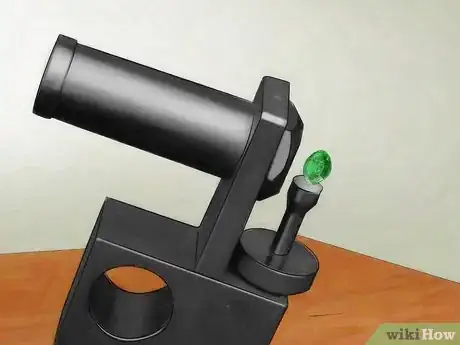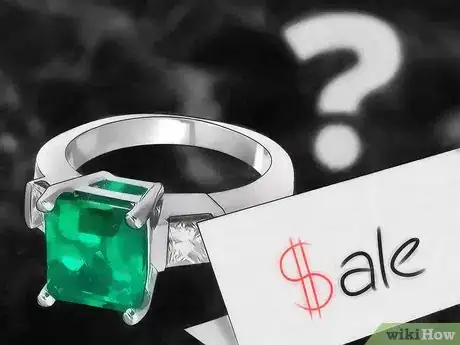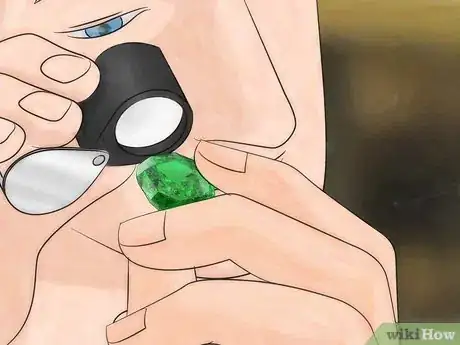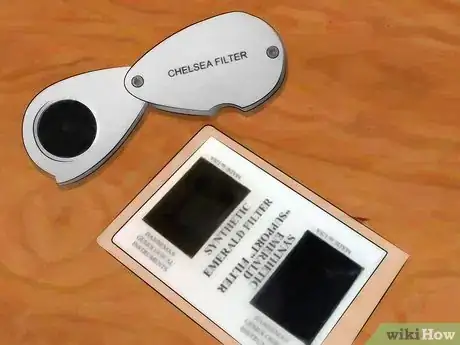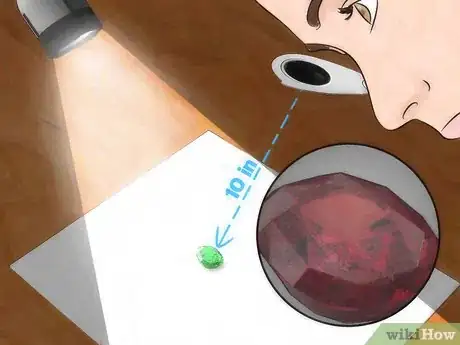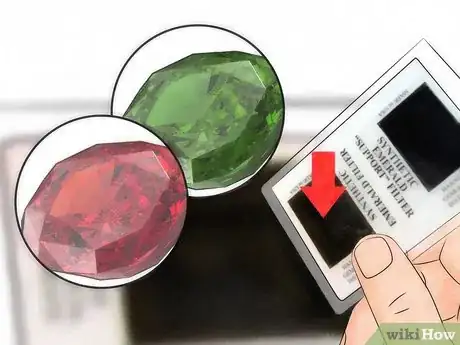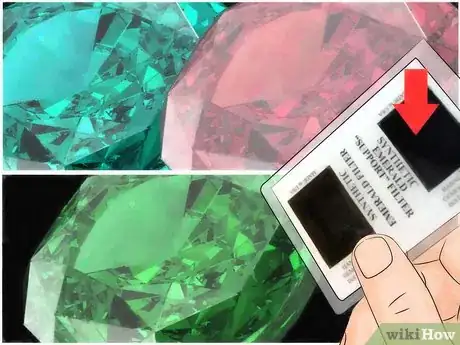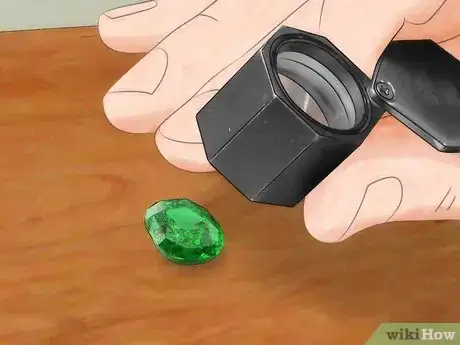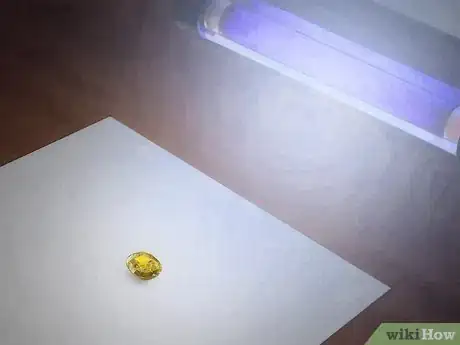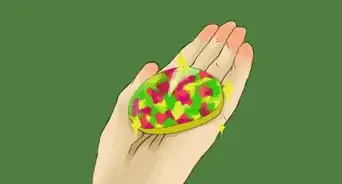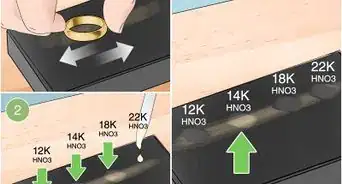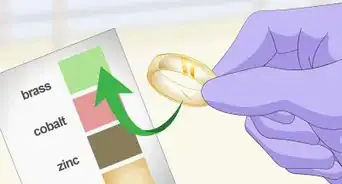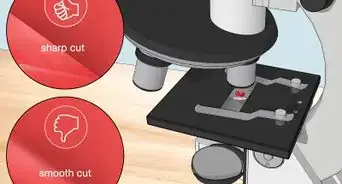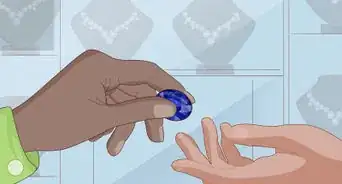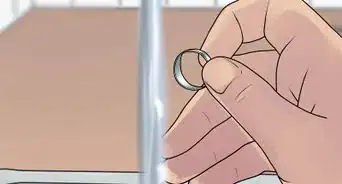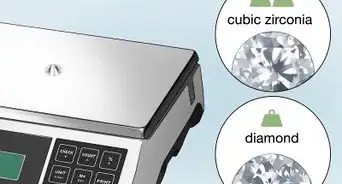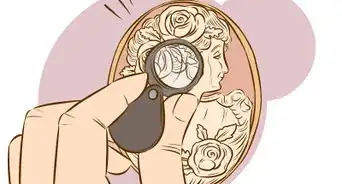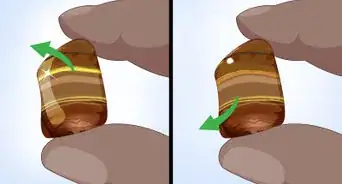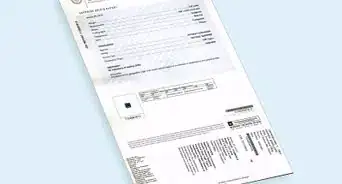This article was co-authored by Kennon Young. Kennon Young is a Master Gemologist Appraiser and the Owner of Vermont Gemological Laboratory in Burlington, Vermont. With over 20 years of experience in the industry, Kennon and his team specialize in handmade engagement rings, wedding bands, and custom jewelry. He attended the Revere Academy of Jewelry Arts, the Gemological Institute of America, and the Rhode Island School of Design Extension. He is a Jewelers of America (JA) Certified Bench Jeweler Technician and received the highest credential in the jewelry appraisal industry, the ASA Master Gemologist Appraiser, in 2016.
There are 17 references cited in this article, which can be found at the bottom of the page.
wikiHow marks an article as reader-approved once it receives enough positive feedback. This article received 21 testimonials and 80% of readers who voted found it helpful, earning it our reader-approved status.
This article has been viewed 533,131 times.
Many "emeralds" are actually other green gems, green glass, or imitations built from several materials. Conduct several tests before you reach a conclusion one way or the other, since results are not always definitive without specialized gemology equipment. If the emerald, you may also be interested in testing whether it is naturally occurring, or a synthetic laboratory creation.
Steps
Evaluating an Emerald
-
1Look for flaws through a magnifying lens or jeweler's loupe. Examine the gem under magnification, ideally through a 10x triple-lens jeweler's loupe. Hold it so light strikes it at an oblique angle, in one narrow beam if possible. If you see tiny flaws or irregular patterns within the stone, it is likely a real gem — although not necessarily an emerald. If your gem is very clear, with almost none of these "inclusions," it may be a synthetic emerald (man-made but real), or not a gemstone at all.
- Gas bubbles only appear in natural emeralds near other inclusions of different shapes. If you see a swarm of bubbles alone, the gem is probably glass — but it could be a synthetic emerald.
-
2Check for a sparkling effect. Real emeralds produce little to no "fire," or colorful flashes that appear under light. If your gem produces a rainbow of flashes, it is not an emerald.[1]Advertisement
-
3Examine the color. The mineral beryl is only called emerald if it is dark green or blue-green. Yellow-green beryl is called heliodor, and light green beryl is just called green beryl.[2] A yellow-green gem might also be olivine or green garnet.[3]
- The line between emerald and green beryl is blurred — two jewelers could disagree over the classification of a gem.
-
4Look for wear on the facets. Glass and other weak materials wear down quickly. If the edges of the facets look soft and worn, the gem is likely fake.[4] Fake glass "gems" often develop a dimpled "orange peel" texture and slightly rounded facet edges. Look for these features under slight magnification.
-
5Check for layers. "Soudé" imitation gems are constructed from two or three layers of different materials, often a green layer in between two colorless stones. If the stone is not mounted, you can easily see these layers by immersing it in water and viewing from the side.[5] It's more difficult to see this in a mounted stone, but you can try examining the area around the girdle for odd color changes.
-
6View the emerald through a dichroscope. Some gemstones appear different colors from different directions, but you'll need a cheap tool called a dichroscope to make this obvious. Hold the gemstone very close to one end of the dichroscope while you look through the viewing window. The gemstone must be illuminated by a strong, diffuse light source as white as possible, such as an overcast sky.[6] Rotate the gemstone and the dichroscope to view it from all directions. Real emeralds are dichroic, appearing blue-green from one angle and a slightly yellow green from another.[7]
- Strong dichroism (two very distinct colors) is a sign of a high quality emerald.[8]
- It is possible to get unusual results due to an internal reflection off a facet, due to properties of fluorescent light, or due to light reaching the viewing window without passing through the gemstone.[9] Use this along with other approaches, not as a single, definitive test.
-
7Beware of cheap prices. If the deal seems too good to be true, trust your instincts. A natural, vividly green emerald with a brilliant luster typically costs at least $500 USD per carat.[10] If the price tag seems suspiciously low, you are probably looking at glass or crystal, not emeralds.
- Synthetic emeralds are much cheaper than natural emeralds, but not as cheap as most other synthetic gems.[11] $75 USD per carat is a ballpark figure for small, synthetic emeralds.
-
8Have the gem appraised. If you still have doubts, take the gemstone to a jeweler and have it professionally appraised. The jeweler will have access to specialized tools that will give you a definitive answer, along with a lengthy description of your gemstone.
- Look for a jeweler with accreditation from a national organization, such as the American Society of Appraisers or American Gem Society. A trade school degree in gemology is also a good sign.
- Avoid appraisers associated with a particular retailer, especially one that is trying to sell you the gemstone you want appraised.
- Fees vary greatly, and may be per-item, per-hour, or per-carat. Do not agree to an appraisal that charges a percentage of the emerald's value.[12]
Identifying Synthetic Emeralds
-
1Understand synthetic emeralds. Synthetic emeralds were grown in a lab, and have the same chemical composition as natural emeralds. These are real emeralds, but cost much less due to the cheaper manufacturing process. If you suspect someone is trying to sell you a synthetic emerald for an inflated price, try the following tests.
- For a definitive test, continue on to the next step to get started using emerald filters.
- If you do not wish to purchase filters, skip down to the other tests. These do still require some tools, as synthetic emeralds are very difficult to identify by eye.
Using Filters
-
1Purchase three emerald testing filters. Look online for a Chelsea filter, a synthetic emerald filter, and a synthetic emerald support filter. These last two are sold as "Hanneman filters" and may be available in a pair. All three filters together could cost $60 USD or more, so this may not be worth it for a single stone.
- In some cases you will also need a jeweler's loupe to examine the emerald up close. This is not necessary for most emeralds.
-
2Look through a Chelsea filter. To get started, examine the emerald through the Chelsea filter:[13]
- Place the emerald under a strong, incandescent light source on a flat, white background. (Fluorescent lights may alter results.)
- Cover any attached metal or other stones with a tissue to prevent reflected colors.
- Hold the Chelsea filter close to your eye and note the color of the stone viewed through the filter, from about 10 inches (25 cm) away or a little closer.
- If the emerald looks red or pink through the Chelsea filter, continue to the next step to test it through the synthetic filter.
- If the emerald looks green through the Chelsea filter, skip down to the support filter step.
- If the emerald looks purplish-red, it is synthetic. Confirm borderline colors by looking through both other filters (synthetic and support) — if it looks greenish through both, it is synthetic. If it looks greenish through synthetic but reddish through support, it is natural.
-
3Follow up with a synthetic filter. If the emerald looked red or pink through the Chelsea filter, it contains chromium. Both natural and synthetic emeralds can contain chromium, so narrow it down with the synthetic filter from an emerald testing kit:[14]
- Move the emerald several inches away from the light source, then view it through the synthetic filter.
- If it looks red or pink again, the gem is a flux-grown synthetic emerald.
- If it look greenish this time, it is a natural emerald, likely Colombian or Russian.
-
4View the gem through a support filter instead. This is only useful if the gem looked green through the Chelsea filter. Follow these steps:[15]
- Move the emerald several inches away from the light source, then view through the support filter.
- If the emerald looks blue-green, lilac, or pink, it is a synthetic, hydrothermal emerald.
- If the emerald still looks greenish (but not blue-green), continue to the next step.
-
5Examine the emerald through a loupe. If the emerald appeared green through the Chelsea filter and through the support filter, it could be natural or synthetic. Fortunately, the synthetic emeralds that match this description tend to look quite different from natural emeralds. Examine emerald through a 10x triple jeweler's loupe:
- If it is clear and almost entirely free of inclusions, it is almost certainly a synthetic, hydrothermal emerald.
- If magnification reveals many small flaws (crystals, needles, wisps, and so on), the gemstone is a natural emerald that contains vanadium and/or iron, such as those mined in Zambia, Brazil, and India.
Other Tests
-
1Examine the inclusions. Early synthetic emeralds had very few inclusions, compared to the many small flaws found in natural emeralds.[16] Later techniques did produce more inclusions, but some types of inclusions only appear in natural emeralds. Look for these under a gem microscope if possible, or through a jeweler's loupe:
-
2Shine a blacklight onto the emerald. For this test, you'll need a "long wave" blacklight — the cheapest, most widely available type. Put your emerald in a dim or dark room. Shine the blacklight onto the gem and watch the color of the fluorescence:
- Yellow, olive-green, or bright red fluorescence is a sure sign of a synthetic emerald.[20] [21]
- No fluorescence at all means the emerald is likely natural, but this is not guaranteed. There is one type of synthetic emerald without fluorescence.[22]
- Dull red or orange-red fluorescence could be natural or synthetic.
Expert Q&A
Did you know you can get premium answers for this article?
Unlock premium answers by supporting wikiHow
-
QuestionHow can you tell if a stone is real or fake?
 Kennon YoungKennon Young is a Master Gemologist Appraiser and the Owner of Vermont Gemological Laboratory in Burlington, Vermont. With over 20 years of experience in the industry, Kennon and his team specialize in handmade engagement rings, wedding bands, and custom jewelry. He attended the Revere Academy of Jewelry Arts, the Gemological Institute of America, and the Rhode Island School of Design Extension. He is a Jewelers of America (JA) Certified Bench Jeweler Technician and received the highest credential in the jewelry appraisal industry, the ASA Master Gemologist Appraiser, in 2016.
Kennon YoungKennon Young is a Master Gemologist Appraiser and the Owner of Vermont Gemological Laboratory in Burlington, Vermont. With over 20 years of experience in the industry, Kennon and his team specialize in handmade engagement rings, wedding bands, and custom jewelry. He attended the Revere Academy of Jewelry Arts, the Gemological Institute of America, and the Rhode Island School of Design Extension. He is a Jewelers of America (JA) Certified Bench Jeweler Technician and received the highest credential in the jewelry appraisal industry, the ASA Master Gemologist Appraiser, in 2016.
Master Gemologist Appraiser
Warnings
- Emeralds are difficult to scratch, but brittle enough to break if smashed. A hammer is not a good test.⧼thumbs_response⧽
References
- ↑ http://www.jewelrynotes.com/how-to-tell-a-fake-emerald-gemstone/
- ↑ http://www.minerals.net/mineral/beryl.aspx
- ↑ http://www.jewelrynotes.com/how-to-tell-a-fake-emerald-gemstone/
- ↑ http://www.jewelrynotes.com/how-to-tell-a-fake-emerald-gemstone/
- ↑ https://books.google.com/books?id=b-7fBAAAQBAJ
- ↑ http://www.gemstones-guide.com/Dichroism-with-Polariscope-Dichroscope.html
- ↑ http://www.geo.utexas.edu/courses/347k/redesign/gem_notes/beryl/beryl_main.htm
- ↑ https://books.google.com/books?id=Zxr5tZF8GPQC&pg=PA103
- ↑ http://www.gemstones-guide.com/Dichroism-with-Polariscope-Dichroscope.html
- ↑ http://www.multicolour.com/emerald/natural-vs-synthetic-emerald.html
- ↑ https://www.gemsociety.org/article/emerald-jewelry-and-gemstone-information/
- ↑ https://gemguide.com/appraisals-reference-guide/fees/
- ↑ https://books.google.com/books?id=qDuSyVsv4VEC
- ↑ https://books.google.com/books?id=qDuSyVsv4VEC
- ↑ https://books.google.com/books?id=qDuSyVsv4VEC
- ↑ https://www.gemsociety.org/article/emerald-jewelry-and-gemstone-information/
- ↑ http://www.minsocam.org/ammin/AM52/AM52_744.pdf
- ↑ http://link.springer.com/referenceworkentry/10.1007%2F978-3-540-72816-0_11294
- ↑ http://www.gemdat.org/gem-1375.html
- ↑ http://www.gemstones-guide.com/Synthetic-Emerald.html
- ↑ http://www.minsocam.org/ammin/AM52/AM52_744.pdf
- ↑ http://www.gemstones-guide.com/Beryl-Emerald-Aquamarine.html#Test_and_Identification_of_Beryl,_Emerald,_Aquamarine
- ↑ http://www.gemselect.com/gem-info/refractive-index.php
- ↑ http://www.geo.utexas.edu/courses/347k/redesign/gem_notes/beryl/beryl_main.htm
- ↑ https://www.cigem.ca/421.html
- ↑ http://www.gemstones-guide.com/Synthetic-Emerald.html
- ↑ https://www.gemsociety.org/article/emerald-jewelry-and-gemstone-information/
About This Article
To tell if an emerald is real, hold it up to a light and look at it closely. If it reflects the different colors of the rainbow, it isn't a real emerald. You can also tell if an emerald is real by looking at its edges. A real emerald has sharp, defined edges, so if the edges you're looking at are dull and worn, it's likely not a real emerald. To learn how you can tell if an emerald is real using a magnifying lens, keep reading!
